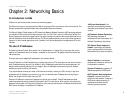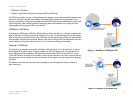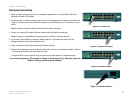
7
Chapter 2: Networking Basics
What is a VPN?
10/100 16-Port VPN Router
• VPN Router to VPN Router
• Computer (using VPN client software that supports IPSec) to VPN Router
The VPN Router creates a “tunnel” or channel between two endpoints, so that data transmissions between them
are secure. A computer with VPN client software that supports IPSec can be one of the two endpoints. Any
computer with the built-in IPSec Security Manager (Microsoft 2000 and XP) allows the VPN Router to create a VPN
tunnel using IPSec). Other versions of Microsoft operating systems require additional, third-party VPN client
software applications that support IPSec to be installed.
VPN Router to VPN Router
An example of a VPN Router-to-VPN Router VPN would be as follows. (See Figure 2-1.) At home, a telecommuter
uses his VPN router for his always-on Internet connection. His router is configured with his office's VPN settings.
When he connects to his office's 10/100 16-Port VPN Router, the two routers create a VPN tunnel, encrypting and
decrypting data. As VPNs utilize the Internet, distance is not a factor. Using the VPN, the telecommuter now has a
secure connection to the central office's network, as if his computer were physically connected.
Computer to VPN Router
The following is an example of a computer-to-VPN Router VPN. (See Figure 2-2.) In her hotel room, a traveling
businesswoman dials up her ISP. Her notebook computer has VPN client software that is configured with her
office's VPN settings. She accesses the VPN client software that supports IPSec and connects to the 10/100
16-Port VPN Router at the central office. As VPNs utilize the Internet, distance is not a factor. Using the VPN, the
businesswoman now has a secure connection to the central office's network, as if her computer were physically
connected.
For additional information and instructions about creating your own VPN, please visit Linksys’s website at
www.linksys.com.
Figure 2-2: Computer-to-VPN Router VPN
Figure 2-1: VPN Router-to-VPN Router VPN


















